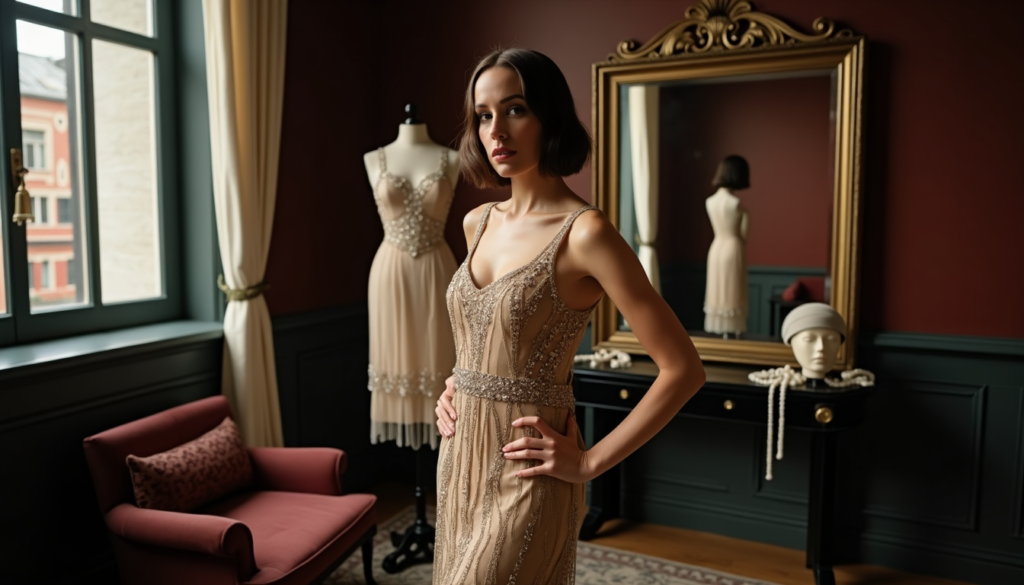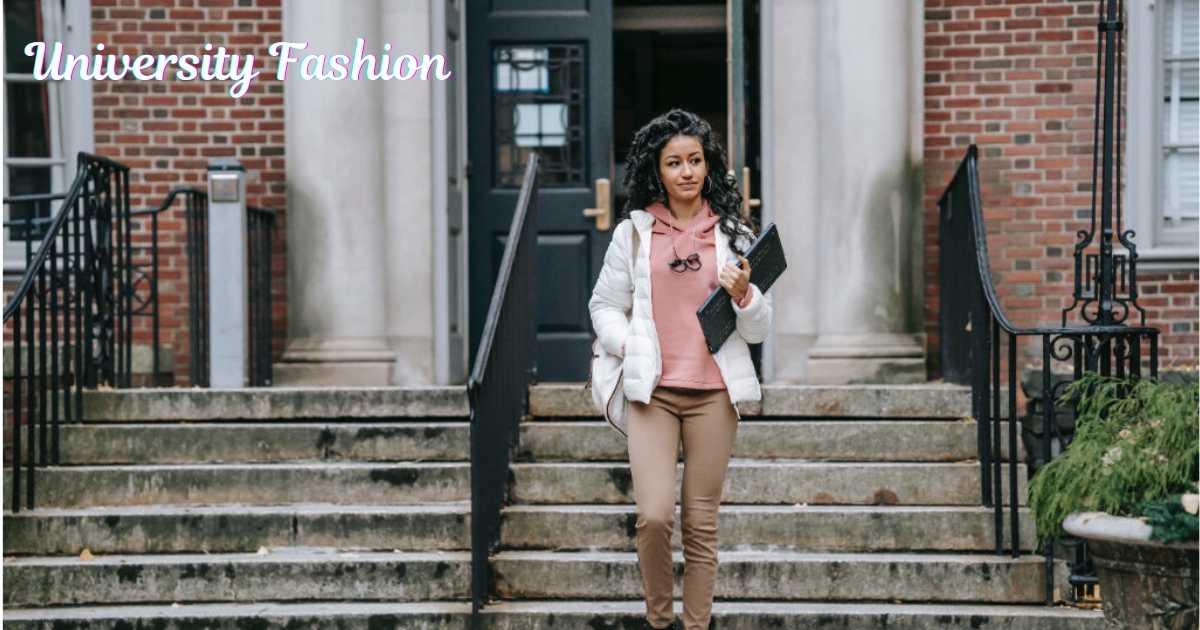
The 1920s Fashion brought a fashion revolution that changed women’s lives. Ladies who once wore ten restrictive undergarments now needed just two or three pieces. This simple change marked a complete break from decades of Victorian clothing traditions.
Women’s right to vote in 1920 sparked new freedom in fashion choices. The bold “flapper” style featured dropped waists and knee-length hemlines that shocked older generations but symbolized liberation. This fashion movement became truly democratic because women across all social classes could recreate these trendy looks at home.
The Social Revolution Behind 1920s Fashion
The 19th Amendment’s passage in 1920 sparked a fashion transformation that went way beyond the reach and influence of style changes. Women’s clothing became a powerful symbol that reflected their expanding roles in society and marked the start of a new fashion era.
The Impact of the Women’s Suffrage Movement
The suffrage movement changed how women used fashion to express their independence. Women’s rights activists opposed traditional fashion in their original stance because they saw it as a form of female oppression. They started breaking away from restrictive clothing and chose attire that showed their strength and independence. This created controversy, as women’s suffrage opponents criticized these fashion choices and portrayed suffragettes as too masculine and outspoken.
Working Women’s Influence on Practical Style
By 1929, more than a quarter of all women, and all but one of these single women had jobs. This surge in employment just needed more functional clothing. Women needed outfits they could wear to clerical work, factory jobs, and store clerk positions. On top of that, sports clothes became substantially more popular in everyday wear, with tennis fashion leading the trend. Modern female wardrobes became more convenient through simpler dress designs that moved away from formal, multi-layered outfits to lighter, more natural styles.
Youth Culture and Fashion Liberation
Youth and beauty became prized commodities during this period and led to major changes in fashion and lifestyle. Women started going to health and beauty clubs to achieve the fashionable slender body type. The mixing of fabrics became popular for evening wear, with dresses adorned with:
- Glass beads and rhinestones
- Fabric flowers and furs
- Sheer materials for sleeves
Hemline changes were among the most striking transformations, reaching knee height by the mid-1920s. Women began wearing flesh-colored stockings to create a bare legs illusion, a daring choice at that time. The “flapper” style, with its dropped waistlines and squared bodies, became freedom’s new symbol. This fashion transformation wasn’t limited to wealthy women – simple lines and economical fabrics like jersey and artificial silk created what fashion experts called a “democratization of fashion”.
How World War I Transformed Female Fashion
World War I didn’t just redraw political maps—it completely changed how women dressed. The war forced the clothing industry to face challenges nobody had seen before, and women’s fashion would never be the same.
Post-War Material Availability
The war changed fashion first through a severe lack of fabric. Military uniforms took priority for wool and other materials. This led to creative changes in women’s clothing. Here’s what happened:
- Nobody could find silk anymore—it became a luxury
- People relied mostly on cotton and wool
- New synthetic materials showed up as options
- Japan stopped sending nylon exports
Women’s New Social Roles
Men went off to fight, and women stepped up to fill their jobs. Their clothes had to change to match their new work life. Women who worked in factories just needed practical clothes—they often borrowed men’s clothing and made it work for them. Women started wearing trousers, which was a huge change. Many added feminine touches like pearls or ruffled collars so society would accept them more easily.
The Death of Formal Dress Codes
Wartime practicality crushed the strict formality of pre-war fashion. The complex dress codes that made people change outfits several times a day started to disappear. Nobody bothered with changing clothes from morning to afternoon anymore. The corset vanished too—replaced by the more practical bra. This switch saved enough steel to build two battleships.
Military style crept into everyday clothes, bringing tunic jackets, belts, and epaulets with it. In spite of that, this wasn’t just about being practical—it showed how society was changing. Women wore simpler clothes with looser fits and different hemlines. Skirts rose to six to ten inches off the ground, a practical change that led to new grooming habits.
Gabrielle “Coco” Chanel became the perfect designer for these austere times. Her practical, no-frills designs matched exactly what people wanted. She opened her first shop in Deauville in 1913. It became the go-to place for wealthy women who wanted redesigned sportswear, marking the start of a new era in fashion.
Cultural Movements Reshaping 1920s Style
Cultural movements of the 1920s Fashion created a vibrant canvas that reshaped women’s fashion. Music, art, and social changes blended to create new style expressions.
The Jazz Age Influence
Jazz music’s wild rhythms sparked a fashion revolution where women needed freedom to move. Dancing became the 1920s style’s heartbeat, and Charleston’s energetic steps made looser, more flexible clothing essential. Women’s dresses changed to feature dropped waistlines and shorter hemlines, letting them move freely on dance floors. Jazz clubs and speakeasies led to evening wear that could handle hours of energetic dancing. These outfits featured beaded fringes and feathers that swayed with each movement.
Art Deco’s Impact on Fashion
France’s Art Deco movement brought a striking new look to women’s clothing. This artistic style introduced:
- Rich colors and geometric shapes in jewelry design
- Symmetrical patterns in dress embellishments
- Clean, bold lines in garment construction
Fashion designers moved away from the curved, flowing lines of previous decades and accepted Art Deco’s architectural influence. This new look reached its peak in evening wear, where lavish beading and sequins created impressive patterns that matched Art Deco’s love for ornate details. The style also changed accessories, with jewelry designers like Raymond Templier drawing ideas from urban machinery and modern life.
The Harlem Renaissance Effect
The Harlem Renaissance brought a unique blend of Black culture and state-of-the-art fashion. This cultural awakening challenged racist stereotypes through sophisticated style choices. The movement’s influence went beyond Harlem, with photographer James Van Der Zee capturing this change through his legendary portrait studio, known as a “studio of transformation”. Fashion became a powerful tool that created new images of Black life in America.
Mainstream fashion felt this influence too. Vogue magazine’s editors often visited Harlem to find inspiration from street fashion shows. This cultural exchange brought bold color combinations and new styling techniques into mainstream fashion. Stars like Josephine Baker made new hairstyles popular, including the fashionable Eton crop, which became a sensation at the Folies Bergère.
International 1920s Fashion Fashion Influences
Three brilliant French designers changed the fashion world of the 1920s Fashion. Their work made Paris the world’s fashion capital.
Paris vs American Style Evolution
French fashion houses led global style trends, with Coco Chanel, Jeanne Lanvin, and Jean Patou at the forefront. Chanel created groundbreaking designs like the iconic little black dress that showed simplicity and elegance. Lanvin made clothes that sparkled with romantic sophistication through detailed embroidery and bold colors. Patou brought his own changes to sportswear by creating the tennis skirt, which made athletic wear both practical and stylish.
While Paris ruled women’s fashion, London set the standards for men’s clothing. The Prince of Wales, who later became Edward VIII, shaped men’s style with:
- Two-piece suits replacing three-piece ensembles
- Pinstripes and tweeds becoming popular
- Bowler hats emerging as a signature accessory
Eastern Influences on Western Fashion
The 1920s saw Eastern design elements reshape Western fashion deeply. Western designers did more than just admire Eastern esthetics—they created a rich cultural exchange. Textiles and clothes became key elements in this cross-cultural conversation. Western designers wove Eastern patterns, construction methods, and design principles into their work.
Eastern influences showed up in many ways:
- Silk imports from China
- Indian textile patterns
- Japanese kimono-inspired designs
- North African caftan adaptations
Global Fashion Exchange
The 1920s Fashion brought fashion to everyone. Women of all social classes could recreate popular looks at home because of their simple styles. This easy access, plus inspiration from working-class clothes and artificial silk, created a new fashion democracy.
Fashion ideas spread worldwide and led to today’s modern fashion cycle. Department stores started using mannequins to display new styles and show how to mix and match the latest trends. Art movements like surrealism changed fashion design too. Italian designer Elsa Schiaparelli added “beyond the real” elements to her creations.
Fashion marketing grew powerful during this time. Magazines and retail displays helped spread style information across continents. This worldwide exchange created new ways for fashion trends to move quickly between countries and cultures. These patterns of global influence still shape the fashion industry today.
Media’s Role in the 1920s Fashion Fashion Revolution
Mass media became a powerful force in the 1920s Fashion and changed how fashion trends moved through society. New communication channels created fresh ways to spread style inspiration and fashion awareness.
Hollywood’s Fashion Influence
The silver screen introduced a new breed of style icons through its most captivating stars. Clara Bow, the ultimate flapper girl, created countless fashion trends with her signature look. Stars like Pola Negri set personal style trends that would appeal to audiences. When she started dyeing her white satin shoes to match her outfits, thousands of women did the same.
Hollywood’s costume designers shaped fashion trends just as much. Gilbert Adrian led Metro-Goldwyn-Mayer’s costume department from 1928 to 1941 and launched several fashion crazes with his innovative designs. His work and that of other designers helped establish Hollywood as a respected fashion authority. Some notable influences included:
- Clara Bow popularized sailor pants and pleated skirts
- Jean Harlow introducing the platinum blonde trend
- Veronica Lake launching the peek-a-boo bangs hairstyle
- Dorothy Lamour is making the sarong a fashion staple
Magazine Culture and Style
Fashion magazines went through remarkable changes during this period. Condé Montrose Nast bought Vogue magazine in 1909 and turned it from a weekly society journal into fashion’s leading authority. The publication hired Baron Adolph de Meyer as their first official photographer in 1913. Before that, they relied only on illustrations.
Photography changed how magazines presented fashion. Man Ray created striking commercial fashion photographs from 1920 until 1940. His work featured close-ups, double exposures, and strategic use of shadows. Fashion photography drew inspiration from surrealism and challenged traditional views of beauty and style.
Fashion Marketing Birth
Modern fashion marketing was born in the 1920s. Elinor Glyn created the concept of the “It Girl”—a young woman who combined innocent intrigue with magnetic appeal. Her sister, Lucile, Lady Duff-Gordon, started fashion shows with live models. She gave them romantic names like Arjamand and Gamela.
Marketing strategies grew beyond their traditional limits. About 40 percent of the population owned radios by 1929, which sometimes broadcast fashion-related content. Modern advertising also emerged as dedicated teams developed sophisticated marketing messages for clothing companies.
Coco Chanel showed the power of brand-building during this era. She launched her signature scent, Chanel No. 5, in 1921 with her self-designed logo—the interlocking ‘C’s that became a timeless symbol of luxury. This was one of the first times fashion grew into a complete lifestyle brand.
Conclusion
The fashion revolution of the 1920s Fashion changed everything. Clothing became more than just something to wear – it turned into a powerful symbol of women’s freedom and social advancement. Women’s suffrage, wartime needs, and cultural movements like jazz and Art Deco made fashion accessible to everyone.
Designers like Coco Chanel and Jean Patou were vital to this change, but their influence reached well beyond their fashion houses. Working women just needed practical clothes, and new media channels helped spread style ideas to all social classes. The flapper look, with its dropped waist and shorter hemlines, became a symbol of freedom that still appeals to us today.
This incredible era shows us how fashion can both reflect and drive social change. The 1920s style wasn’t just about esthetics – it proved women’s determination to break away from old traditions. Modern fashion continues to draw inspiration from this decade, showing us how our clothing choices can shape and mirror society’s progress.
FAQs
How did women’s fashion evolve in the 1920s?
Women’s fashion in the 1920s underwent a dramatic transformation, featuring shorter hemlines, looser silhouettes, and dropped waistlines. This new style, epitomized by the “flapper” look, reflected women’s growing independence and societal changes of the era.
What were the key influences on 1920s fashion?
The 1920s fashion was shaped by various factors, including the women’s suffrage movement, World War I, the rise of working women, and cultural movements like the Jazz Age and Art Deco. These influences led to more practical, comfortable, and expressive clothing styles.
How did the media impact fashion trends in the 1920s?
Media played a crucial role in spreading fashion trends during the 1920s. Hollywood stars became style icons, fashion magazines like Vogue gained prominence, and the rise of fashion photography and advertising contributed to the rapid dissemination of new styles across social classes.
What role did designers play in shaping 1920s fashion?
Designers like Coco Chanel, Jeanne Lanvin, and Jean Patou were instrumental in shaping 1920s fashion. They introduced revolutionary designs such as the little black dress, sportswear-inspired clothing, and simplified silhouettes that embodied the era’s spirit of modernity and freedom.
How did the 1920s fashion revolution impact society?
The fashion revolution of the 1920s symbolized broader social changes, particularly for women. It represented a break from restrictive Victorian traditions, reflected women’s expanding roles in society, and contributed to the democratization of fashion, making stylish clothing accessible to a wider range of social classes.



